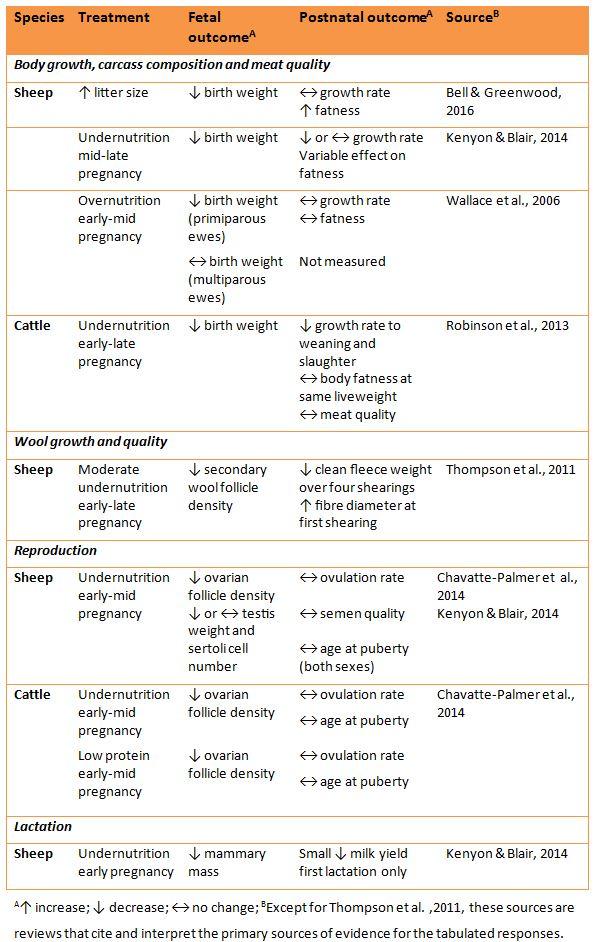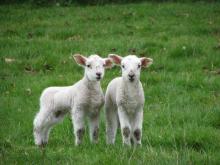Nutrition during gestation influences postnatal productivity of ruminant livestock
By Alan Bell1 and Paul Greenwood2,3
1Department of Animal Science, Cornell University, Ithaca NY 14853-4801, USA. awb6@cornell.edu; 2NSW Department of Primary Industries Beef Industry Centre, University of New England, Armidale, NSW 2351, Australia; 3CSIRO Agriculture, Armidale, NSW 2350, Australia. paul.greenwood@dpi.nsw.gov.au
Introduction
It has been long known that severe undernutrition of pregnant cows and sheep, especially during late gestation, can permanently retard body and wool growth of their offspring. However, the idea that maternal nutrition at various stages of pregnancy can indelibly influence lifetime productivity and health of progeny has gained additional currency from more recent epidemiological studies of human populations and detailed experimental studies of rodents as well as livestock species (Bell and Greenwood 2016). These observations have formed the basis of the so-called “developmental origins hypothesis” as originally proposed by the British epidemiologist David Barker and his colleagues (Barker 2007).
The evidence for effects of prenatal nutrition on postnatal development of a wide variety of tissues directly related to the production of meat, milk and wool, as well as reproduction, is now indisputable. However, despite the unqualified excitement of some researchers for these demonstrated phenomena, their quantitative significance for the productivity and management of livestock production systems remains to be established. In this piece we attempt to evaluate current evidence for the magnitude and commercial relevance of observed postnatal responses to the management of breeding flocks and herds. For more detailed summaries and interpretation of this evidence, see recent reviews by Robinson et al. (2013), Kenyon and Blair (2014) and Bell and Greenwood (2016).
Body growth, carcass composition and meat quality
In sheep and cattle, severe maternal undernutrition after mid pregnancy can decrease the growth trajectory of offspring to weaning and beyond, with negative consequences for time and associated costs to reach market weight. In growth-retarded lambs, this has been associated with increased carcass fatness at any given empty body weight to weaning. However, in growth-retarded beef calves any effects of prenatal nutrition on carcass composition at a given slaughter age were less apparent and could be explained mostly by effects on carcass weight (see Robinson et al. 2013).
Similarly, we and others have found little effect of prenatal growth retardation on beef quality. For example, in the offspring of Hereford cows mated to Piedmontese or Wagyu bulls which had suffered a 10.5 % penalty in birth weight due to maternal underfeeding, there were biologically insignificant effects on retail beef yield and meat colour, marbling and tenderness.
In sheep, overnutrition of mature, pregnant dams caused substantial increases in maternal body weight and fatness but had little effect on fetal growth. In contrast, overnutrition of adolescent ewes has been repeatedly and consistently associated with impaired placental growth and substantially decreased birth weights (see Wallace et al. 2006). The long-term postnatal consequences of this prenatal growth retardation remain to be studied in detail. Also, it is notable that not all researchers have been able to replicate the phenomenon in first lamb ewes (see Kenyon and Blair 2014).
Wool growth and quality
Australian studies of the long-term effects of realistic variations in maternal nutrition and body weight changes during pregnancy in Merino ewes have revealed commercially relevant effects on clean fleece weights of progeny over four shearings up to 51 months of age (see Thompson et al. 2011). Improving maternal nutrition also tended to decrease wool fibre diameter thereby increasing wool quality but this effect on productivity was less consistent and less quantitatively or commercially significant than the persistent positive effect on fleece weight.
These large, long-term studies also demonstrated that the prenatal penalties on postnatal body and wool growth of twin lambs could largely be overcome by early identification of the pregnancy status and consequent feed supplementation of their dams. While the effects on wool production alone were deemed to justify the extra cost of feeding during pregnancy, the additional benefits to twin lamb survival were judged to be an even more important driver of overall productivity.
Reproduction and lactation
Negative effects of maternal energy and(or) protein deprivation of pregnant ewes and cows during early, mid and(or) late pregnancy on reproductive development of female and, to a lesser extent, male offspring have been demonstrated in terms of ovarian follicle number and altered testes cellular structure (Chavatte-Palmer et al. 2014; Kenyon and Blair 2014). However, these effects generally were small and have yet to be translated into convincing evidence for impaired reproductive performance under practical conditions of breeding management. It also is notable that, notwithstanding the well-established relation between postnatal growth and timing of puberty in sheep and cattle, prenatal growth retardation due to maternal underfeeding throughout pregnancy has not been shown to have a significant effect on this aspect of reproductive efficiency.
Recent studies in New Zealand have shown that plane of nutrition of pregnant ewes can have modest effects on mammary development and milk production of their female progeny during the first lactation (see Kenyon and Blair 2014). However, the effects on milk yield did not persist beyond the first lactation. Also, any nutritional effects on mammogenesis were trivial in comparison to those demonstrated in ewes and cows around puberty and during late pregnancy.
Possible mechanisms
Recent versions of the developmental origins theory have proposed that most effects of prenatal nutrition on postnatal development are mediated by nutrient-responsive changes in epigenetic influences on the expression of key regulatory genes in fetal tissues. So far, convincing evidence for this proposal has been confined mostly to inbred lines of rodents. However, it is likely that similar epigenetic mechanisms will be found to operate in other species including ruminant livestock. These may include epigenetic modulation of placental function to ameliorate some of the negative effects of maternal undernutrition on fetal development (see Bell and Greenwood 2016).
Conclusions
- It is now clear that prenatal nutrition can influence postnatal growth, body composition, wool growth and reproductive performance in sheep and cattle. However, with the possible exception of lifetime wool growth, these effects are usually subtle and often ameliorated by postnatal nutritional experience.
- The relevance of developmental origins phenomena to practical management systems must be considered in the context of the major drivers of productivity which, in beef and lamb production systems, are weaning rate and maternal efficiency. Where the benefits of improving maternal nutrition extend to the latter outcomes, such as in the case of increased survival of twin lambs, a clear win-win situation can be achieved.
- The magnitude and transgenerational persistence of prenatal effects, including those mediated by epigenetic modifications of the genome, need to be better quantified in livestock species.
Further reading
- Barker, D. J. P., 2007. The origins of the developmental origins theory. Journal of Internal Medicine, 261: 412-417. http://dx.doi:10.1111/j.1365-2796.2007.01809.x
- Bell, A. W., Greenwood, P. L., 2016. Prenatal origins of postnatal variation in growth, development and productivity of ruminants. Animal Production Science, 56: 1217-1232. http://dx.doi.org/10.1071/AN15408
- Chavatte-Palmer, P., Dupont, C., Debus, N., Camous, S., 2014. Nutritional programming and the reproductive function of the offspring. Animal Production Science, 54: 1166-1176. http://dx.doi.org/10.1071/AN14470
- Kenyon, P. R., Blair, H. T., 2014. Foetal programming in sheep – effects on production. Small Ruminant Research, 118: 16-30. http://dx.doi.org/10.1016/j.smallrumres.2013.12.021
- Robinson, D. L., Cafe, L. M., Greenwood, P. L., 2013. Developmental programming in cattle: consequences for growth, efficiency, carcass, muscle, and beef quality characteristics. Journal of Animal Science, 91: 1428-1422. http://dx.doi.org/10.2527/jas.2012-5799
- Thompson, A. N., Ferguson, M. B., Gordon, D. J., Kearney, G. A., Oldham, C. M., Paganoni, B. L., 2011. Improving the nutrition of Merino ewes during pregnancy increases the fleece weight and reduces the fibre diameter of their progeny’s wool during their lifetime and these effects can be predicted from the ewe’s liveweight profile. Animal Production Science, 51: 794-804. http://dx.doi.org/10.1071/AN10161
- Wallace, J. M., Luther, J. S., Milne, J. S., Aitken, R. P., Redmer, D. A., Reynolds, L. P., Hay, W. W., Jr, 2006. Nutritional modulation of adolescent pregnancy outcome – a review. Placenta, 27 (Suppl.): 61-68. http://dx.doi.org/10.1016/j.placenta.2005.12.002
Photo credit: Evelyn Simak, Wikimedia Commons, CC-BY-SA 2.0 Generic



